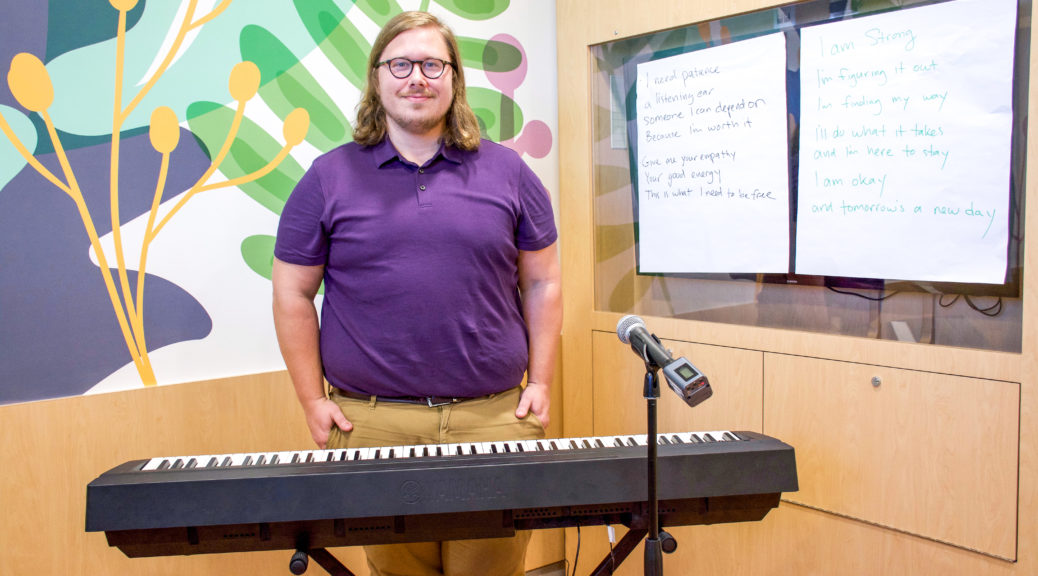Music therapy has been part of CHOC specialized therapeutic programming for more than 10 years. The program has grown recently, due to increased awareness of its effectiveness and a rising need among CHOC patients. We sat down with Kevin Budd, a board-certified music therapist in CHOC’s Mental Health Inpatient Center, to discuss the benefits of music therapy in an inpatient psychiatric setting.

What comprises music therapy as a practice?
Music therapy is the clinical, evidence-based use of musical interventions to accomplish individualized goals. This occurs within a therapeutic relationship between a credentialed professional who has completed an approved music therapy program and a patient. During music therapy, we address physical, psychological, cognitive and/or social functioning challenges for patients of all ages. Essentially, music is the tool that helps support a patient’s non-musical need.
How does music therapy support clinical goals?
A patient’s clinical goal is the starting point for determining which musical intervention will be most effective. In the Center, these goals could include: mood regulation, self-expression, self-esteem, anxiety, interpersonal effectiveness, treatment motivation, positive coping skills and others. There’s no one-size-fits-all treatment when it comes to music therapy and mental health. We might work towards a patient’s goals several different ways, such as through focused music listening, songwriting, song discussion, group instrument playing, music and relaxation, singing and more.
Music therapists rely on assessment, treatment planning and evaluation to determine whether a patient’s current music therapy methods are meeting their needs. Without treatment goals, there could be no effective music therapy.
What is an example of using music therapy to address a clinical goal?
If a patient’s clinical goal is to increase identification of positive coping skills, we might work on lyric analysis within the patient’s preferred style of song. We could discuss triggers, resilience and negative life situations in the song. After this discussion, we could rewrite the chorus of the song, including identification of a negative situation and a positive coping skill to help address it. The patients can then be encouraged to share what they created—by singing, spoken word or other creative means.
Within this exercise, not only has the patient used a creative medium to identify a negative situation and how to cope with it; they have also built confidence after completing and sharing their creation, felt more connected with others in the group by being vulnerable and feeling validated, improved their mood and increased their treatment motivation.
What kind of impact have you seen in mental health patients who have participated in music therapy?
Sometimes it’s hard for patients to verbalize past trauma or express their struggles. But with music therapy, they can discuss a song that relates to their current situation—whether it is bullying, family problems, hopelessness, anxiety or another stressor. During this process, patients may be able to process and verbalize more, since the lyrics are an easier gateway for expression.
During group ukulele playing, patients who have difficulty with interpersonal relationships can cohesively and successfully play music together in a positive, supportive space without the need to talk. They can work on distress tolerance and problem-solving skills while persevering through a challenging task—and by the end, they have improved self-esteem.
In any setting, music instantly affects our bodies—mentally, physically and behaviorally. It’s amazing how one musical intervention can address multiple goals.
What is unique about music therapy in an inpatient psychiatric facility?
Music therapy can look different in the inpatient psychiatric setting than in other areas of the hospital. Within the Center, goals for music therapy are focused on combatting the reasons why a patient is admitted—these could include suicidal ideation, depression, anxiety or other factors keeping a patient from participating in a healthy way in daily life. The goal of the MHIC is to stabilize these patients and provide them with as many resources as possible to cope with their mental health challenges.
Music therapy does just that and provides opportunities for patients to learn, process, practice and discover new skills through tailored music interventions. The MHIC offers opportunities for a diverse group of kids and teens to express themselves in a supportive, safe and validating environment. Individual music therapy sessions are available to patients in the Center who need additional one-on-one support to complement their other treatment.
Why did you want to become a music therapist? Why a mental health setting specifically?
I’ve gone through my own mental health challenges throughout my life, and I always found that music validated my journey. Music helped me distract myself and process my feelings. Music met me where I was in the moment and gave me hope. It also gave me a platform to express myself in ways I didn’t know how to otherwise.
When considering career paths, I wanted to find a way to harness the role music had played in my life in a therapeutic way. After receiving my undergraduate degree in music, I developed a special interest where psychology and music intersect—the space where music therapy truly breathes. I pursued my graduate degree in music therapy and then became a board-certified music therapist.
I feel humbled and fulfilled to be able to support kids and teens at CHOC with the tool of music. By creating an authentic therapeutic alliance, I can support them through a harsh and challenging time in their lives. I am thrilled to be on the front lines of the music therapy program at CHOC, and I look forward to supporting its growth and success in treating pediatric patients.




